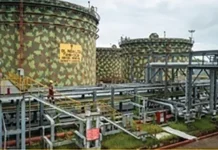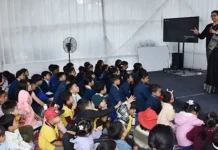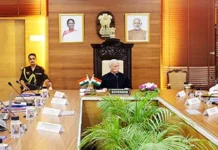NEW DELHI, 17 Feb: The Rashtrapati Bhavan here was a spectacle of cultural vibrancy and unity as it successfully concluded the first chapter of the biannual extravaganza ‘Vividhata ka Amrit Mahotsav’, focused on celebrating the rich tapestry of Northeast India’s diversity.
The event, which was inaugurated by President Droupadi Murmu, alongside DoNER Minister G Kishan Reddy and Earth Sciences Minister Kiren Rijiju, received accolades from MPs, governors and cabinet ministers from the Northeast, and a myriad of officials, guests and visitors.
Murmu commended the initiative and applauded the organisers for “weaving together the rich tapestry of Northeast India at the premise of Rasthtrapati Bhavan,” and urged citizens to “experience and explore the rich diversity of enchanting Northeast India.”
The event was organised by the DoNER ministry, and managed through its CPSE, the Northeastern Handicrafts & Handlooms Development Corporation Limited (NEHHDC).
The biannual event was held as a part of Udyan Utsav-2024 at the Amrit Udyan inside the Rashtrapati Bhavan premises, inviting attendees with free entry.
With meticulous planning and dedication, the cultural odyssey marked the dawn of the first chapter of Vividhta ka Amrit Mahotsav, which enthralled visitors with vibrant showcasing of indigenous handloom and handicrafts products, traditional culinary delights, and cultural performances from the eight culturally diverse states of the Northeastern region, called ‘Ashtalakshmi of India’.
The celebration featured 300+ artisans and 400+ artists from the Northeast engaging in a myriad of cultural folk performances, art exhibitions, ethnic fashion shows, and interactive live demonstrations of handcrafted wonders of the Northeast, like loin loom woven items, lotus silk extraction, muga silk reeling, thangka painting, tribal jewellery, pottery, organic items, bamboo and cane souvenirs, basketry, and sustainable home decoration products, alongside GI agro-products and textiles of the region.
The rich culture and colourful festivals of the Northeast region were portrayed through spectacular performances by 300 artists during the Asthalaxmi Rangoli. Beyond its cultural significance, the festival was envisioned as a platform for economic opportunities, fostering exchanges in traditional handicrafts, and promoting indigenous handlooms and agro-products.
It provided a platform for artists, artisans, and culinary experts from the NE states to showcase their talents and craftsmanship. The event also served as a bridge connecting to the larger stakeholders, and was aimed at leveraging and catalysing the growth and development of the NE region, transforming it into a hub of cultural and economic prosperity.
The overwhelming turnout and the positive reception of the event was testament to the unity in diversity that forms the cornerstone of the Indian ethos.
As the event concluded, the organisers – the Rashtrapati Bhavan, the DoNER ministry, the NEHHDC, the culture ministry, and the NEZCC – expressed gratitude to all the participants, supporters and visitors for making the festival a memorable and impactful affair which witnessed an overwhelming response, with a total of around 1.5 lakh visitors attending it from 8 to 11 February.




